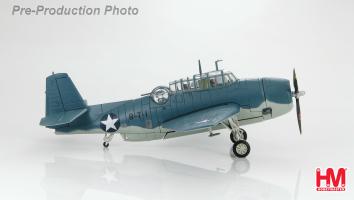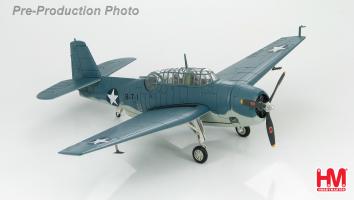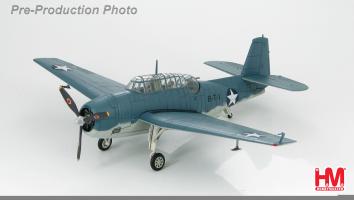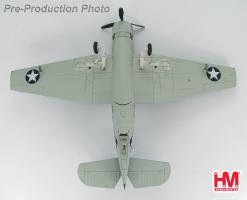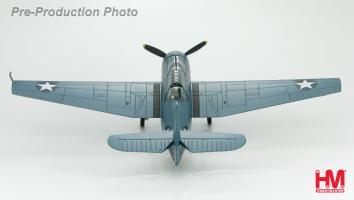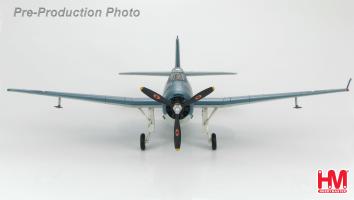Hobby Master Archive
Air Power Propellers 1/72
TBF/TBM
Grumman TBF-1 Avenger VT-8 June 1942 Battle of Midway This was the only Avenger to survive this battle
Hobby Master 1/72 Air Power Series HA1214 Grumman TBF-1 Avenger VT-8 (The Flying Eights) June 1942 “Battle of Midway” This was the only Avenger to survive this battle
Specifications for the Grumman TBF-1 Avenger Type - Carrier based Torpedo bomber Manufacturer - Grumman Aircraft Models: TBF (manufactured by Grumman) and TBM (manufactured by a GM subsidiary) series Crew - (3) Pilot / Radio Operator / Rear Gunner First Flight - August 1, 1941 Service Delivery - January 30, 1942 Dimensions Wing Span - 54 ft. 2 in. (16.5 m) Length - 40 ft. (12.2 m) Length - 40 ft. 11.5 in. (12.48 m) Height - 16 ft. 5 in. (5 m) Weight Empty - 10,100 lb (4,580 kg) Maximum - 15,905 lb (7,214 kg)
Performance Engine - (1) Wright R-2600-8 Double cyclone, 14-cylinder dual-row radial, 1,700 hp Max. Speed - 278 mph (445 km/h) Initial Climb - 1,075 ft/min (376 m/min) Service Ceiling - 23,400 ft. (7132 m) Maximum Range (Full weapons load) - 1,010 - 1,215 miles (1,600 -1,950 km) Maximum Range (Ferry tanks) - 2,530 miles (4072 km) Armament (1) .50 Browning in powered dorsal turret (1) .30 Browning fixed above engine (1) .30 Browning manually aimed in rear ventral position Bomb Load 2,000 lb. (454 kg) of bombs or (1) 22 in. torpedo stored internally
Just prior to the start of WW II the USN started to look for a replacement for their aging Douglas Devastator. Grumman made a presentation of a prototype labeled as XTBF-1 that impressed the USN and they placed an order to purchase. The plane was perfect for the Navy needs, a huge rotary engine that was enclosed in a barrel like fuselage to cut down on drag, and with some increase in the fuselage and wing lengths would accommodate a three-man crew. Production on what was now officially known as the TBF Avenger and would come to receive the affectionate name of “The Turkey” from the pilots that flew them began in 1941 with first delivery just in time for the Battle of Midway in June 1942. What started out as a carrier borne torpedo bomber soon turned into a close-support bomber, a patrol aircraft and even a trainer.
Because of Grumman’s commitments to produce other aircraft and the fact that this plane was so well liked and in such demand they had to contract the work out to General Motors. Grumman continued to make the Avenger until December 1943. The Grumman plane was designated the TBF and the General Motors plane was the TBM. Of the 9,836 planes manufactured, GM made 7,546 of them.
VT-8 Torpedo Squadron 8 was a USN squadron assigned to the aircraft carrier USS Hornet. The squadron joined the ship shortly after the ships commissioning in October 1941. VT-8s first and best-known combat mission came during the Battle of Midway on June 4, 1942. As part of the U.S. plan to counter the Japanese attack on Midway Island and deliver a death blow to the Japanese Fleet the USS Hornet launched 15 Douglas TBD Devastators and all but one was shot down without doing any damage to the Japanese carriers. VT-8 was the first squadron to receive the new Grumman TBF-1 Avenger, a bigger, faster, longer-ranged replacement for the TBD. On June 4, 1942 six of VT-8s new Grumman Avengers were on Midway and along with other aircraft located there launched prior to the Japanese assault. Of the six TBF-1s launched only one survived. The one aircraft was 8-T-1 (Bureau # 00380) piloted by Ensign Albert K. Earnest with Radioman 3/c Harry Ferrier who both survived the ordeal. Seaman 1/c Jay D. Manning was operating the .50 caliber machine gun and was killed in action by Japanese fighters. The aircraft was so badly damaged that it was considered beyond repair.
At the end of the day VT-8 was virtually eliminated. It wasn’t long though before VT-8 received new pilots and was fully equipped with the new TBF-1s. They went on to fight during the Battle of Guadalcanal and through the Solomon’s campaign.
Superb detailing in 1/72 scale. Pre-painted with pad applied markings. Fully assembled. Weapons are not permanently attached. Bomb bay can be displayed open or closed. Display stand included. Option to display model with wheels up or down. Minimum use of plastic. Very collectable.
| Added to archive | 2016-08-01 |
| Last modified | 2016-08-01 |
| Leaflet | 2009-06-01 June 2009 |
